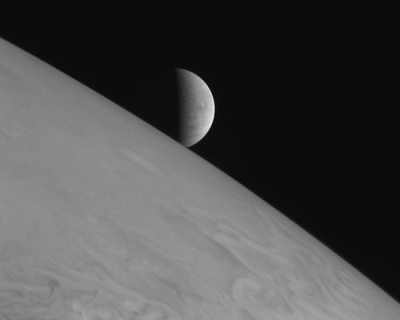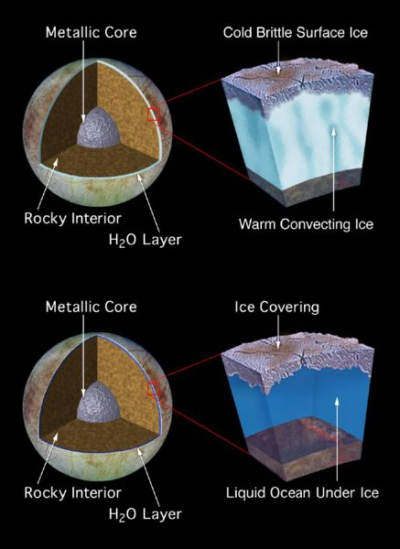07 May 2007

Credit: NASA/JHUAPL/SwRI
NASA recently published an awesome image of Jupiter and its intriguing moon, Europa, obtained by the Pluto-bound, New Horizons spacecraft.
The artful view shows icy Europa (3,120 km across) rising over the Jovian horizon. It was nearly half-lit.
The image was taken with New Horizon's Long Range Reconnaissance Imager (LORRI) at 11:48 UT on 28 February 2007, 6 hours after the spacecraft’s closest approach to Jupiter.
This picturesque alignment was suggested by space enthusiast Richard Hendricks of Austin, Texas, in response to an Internet enquiry by New Horizons scientists for evocative, artistic views of the Jovian system.
The spacecraft was 2.3 million km from Jupiter, and 3 million km from Europa, when the picture was taken. To fulfill its artistic attitude, the image was rotated so south is up.
Europa is the 6th Jovian moon, in order of distance from the planet. It is slightly smaller than our Moon (3,476 km across). It is somewhat similar in composition to the terrestrial planets, but its smooth surface is unique in the Solar System.
Compared to other planetary bodies, Europa's surface may be likened to billiard ball, with only a few low-relief surface markings. Also, few meteoritic craters have been detected on Europa, indicating a young and geologically active surface.

Europa's Subsurface Ocean
Credit: NASA
Strong evidence demonstrates that Europa probably has an ocean of liquid water beneath its icy crust. This discovery has stimulated speculation about the possibility of life in this hypothetical ocean.
Further Reading
New Horizons
http://pluto.jhuapl.edu/index.php
Aymen Mohamed Ibrahem